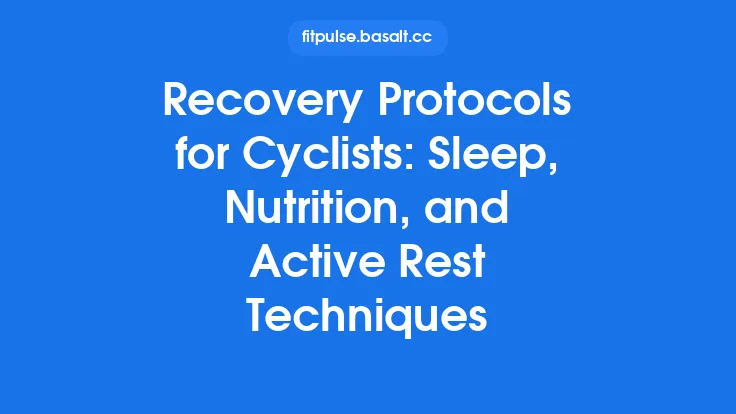Motor learning does not occur in a vacuum; the brain and body require both stimulus and recovery to transform repeated movement attempts into stable, efficient performance. While countless repetitions can engrain a pattern, insufficient rest can lead to fatigue‑induced errors, diminished neural plasticity, and even injury. Conversely, excessive downtime may cause decay of the nascent motor trace before it has been fully consolidated. The art of balancing rest and repetition lies in understanding how the nervous system encodes, stabilizes, and refines movement, and then structuring practice sessions to align with those biological processes.
The Physiology of Motor Consolidation
When a novel movement is executed, sensory receptors (muscle spindles, Golgi tendon organs, joint capsule afferents) transmit a barrage of proprioceptive information to the primary motor cortex, cerebellum, and basal ganglia. This influx triggers a cascade of intracellular events—calcium influx, activation of protein kinases, and gene transcription—that lay down short‑term synaptic modifications. However, for these changes to become durable, they must undergo offline consolidation, a process that predominantly occurs during periods of low neural activity such as sleep or quiet wakefulness.
Key mechanisms include:
- Synaptic Tagging and Capture: Initial practice tags specific synapses, marking them for later reinforcement. Subsequent rest allows neuromodulators (e.g., dopamine, acetylcholine) to “capture” these tags, strengthening the connections.
- Systems Consolidation: Over hours to days, memory traces shift from hippocampal‑dependent networks to distributed cortical representations, making the skill more resistant to interference.
- Myelination and Structural Remodeling: Repeated activation promotes oligodendrocyte proliferation and myelin sheath thickening, which speeds signal transmission along motor pathways.
Understanding that consolidation is time‑dependent underscores why spacing practice bouts—rather than cramming them—can yield superior learning outcomes.
The Role of Fatigue in Motor Encoding
Fatigue is not merely a peripheral phenomenon; it exerts profound effects on central motor command. As muscular fatigue sets in, the central nervous system compensates by altering motor unit recruitment patterns, increasing co‑contraction, and relying on less efficient movement strategies. These compensations can become encoded if practice continues under fatigued conditions, leading to:
- Error Propagation: Mistakes made while fatigued are more likely to be stored as part of the motor memory.
- Reduced Neural Plasticity: Elevated cortisol and catecholamine levels during acute fatigue can blunt long‑term potentiation (LTP) in motor cortices.
- Increased Injury Risk: Compromised joint stability and altered biomechanics raise the likelihood of tissue overload.
Therefore, monitoring fatigue and strategically inserting rest intervals is essential to preserve the fidelity of the motor pattern being learned.
Determining the Optimal Repetition Dose
The “right” number of repetitions is highly individual, but research provides useful guidelines:
| Skill Complexity | Typical Repetition Range per Set | Recommended Rest Between Sets |
|---|---|---|
| Simple, low‑load (e.g., basic squat stance) | 8–12 | 30–60 s |
| Moderately complex (e.g., kettlebell swing) | 5–8 | 60–90 s |
| High‑skill, high‑load (e.g., Olympic lift) | 2–5 | 2–5 min |
These ranges reflect a balance between providing enough stimulus to trigger neural adaptation and avoiding the onset of detrimental fatigue. For highly technical movements, fewer repetitions with longer rest allow the practitioner to focus on quality and maintain optimal neural firing patterns.
Spacing Effects: Distributed Practice vs. Massed Practice
Distributed practice—spacing repetitions over time—leverages the brain’s natural consolidation windows. Empirical evidence shows that inter‑trial intervals of 10–30 seconds for simple tasks and 2–5 minutes for complex tasks promote better retention than continuous, uninterrupted repetitions. The underlying rationale includes:
- Reactivation of Memory Traces: Brief pauses allow the brain to reactivate and strengthen the recently formed trace before it decays.
- Metabolic Recovery: Muscles replenish phosphocreatine and clear metabolic by‑products, preserving movement quality.
- Attentional Reset: Short breaks reduce cognitive overload, maintaining focus on movement cues.
When designing a training session, consider a micro‑spacing approach: perform a block of 3–5 repetitions, rest for the appropriate interval, then repeat the block. This pattern can be repeated across multiple sets, providing both neural and muscular recovery.
Sleep: The Ultimate Consolidation Window
Sleep, particularly slow‑wave sleep (SWS) and rapid eye movement (REM) phases, is a critical period for motor memory consolidation. During SWS, the brain exhibits synchronized neuronal activity that facilitates synaptic down‑scaling, preserving the most salient connections formed during practice. REM sleep, on the other hand, is associated with heightened cortical plasticity and the integration of motor sequences.
Practical recommendations:
- Post‑Practice Sleep Window: Aim to obtain at least 90 minutes of sleep within the first 2–3 hours after a training session to maximize consolidation.
- Consistent Sleep Schedule: Regular bedtimes reinforce circadian rhythms, enhancing the efficiency of consolidation processes.
- Avoid Alcohol and Heavy Meals: Both can disrupt SWS architecture, diminishing the benefits of post‑practice sleep.
Nutrition and Recovery Modalities
While rest intervals address the temporal aspect of recovery, the biochemical environment also influences motor learning:
- Protein Intake: Consuming 20–30 g of high‑quality protein within 30 minutes post‑practice supports muscle repair and may indirectly aid neural recovery by reducing peripheral fatigue signals.
- Carbohydrate Replenishment: Restoring glycogen stores ensures that subsequent practice bouts are not limited by energy deficits, which can impair motor output.
- Hydration: Even mild dehydration can affect cognitive function and proprioception, leading to suboptimal movement execution.
- Active Recovery: Low‑intensity activities (e.g., light cycling, dynamic stretching) between sets can accelerate lactate clearance and maintain blood flow to the central nervous system without imposing additional neural load.
Monitoring Fatigue and Readiness
Objective metrics help tailor rest‑repetition ratios to the individual:
- Heart Rate Variability (HRV): Lower HRV indicates heightened sympathetic activity and reduced readiness; extending rest periods may be warranted.
- Rate of Perceived Exertion (RPE): A simple 0–10 scale can flag excessive fatigue; an RPE > 7 during a skill set suggests the need for longer recovery.
- Movement Quality Scoring: Video analysis or sensor‑based kinematic feedback can reveal degradation in technique, prompting a rest break.
By integrating these monitoring tools, coaches and athletes can dynamically adjust practice parameters rather than relying on static prescriptions.
Periodizing Rest and Repetition Across Training Phases
Just as training loads are periodized, so too should the balance of rest and repetition. A typical macro‑cycle might include:
- Acquisition Phase (Weeks 1‑4): Emphasize high‑frequency, low‑volume practice with generous rest to establish accurate motor patterns.
- Refinement Phase (Weeks 5‑8): Increase repetition density while slightly reducing rest, encouraging the nervous system to adapt to higher demand.
- Performance Phase (Weeks 9‑12): Introduce sport‑specific or task‑specific simulations with variable rest intervals that mimic competition conditions.
Each phase should be accompanied by systematic assessments to ensure that the rest‑repetition balance remains optimal for the learner’s current stage.
Practical Session Blueprint
Below is a template for a 60‑minute skill‑focused session targeting a moderately complex movement (e.g., kettlebell clean):
| Time | Activity | Repetitions | Rest |
|---|---|---|---|
| 0‑10 min | Warm‑up (dynamic mobility, light cardio) | — | — |
| 10‑15 min | Skill demonstration & cueing | — | — |
| 15‑25 min | Block 1: 4 × 5 reps (focus on form) | 5 | 90 s |
| 25‑30 min | Active recovery (light jogging) | — | — |
| 30‑40 min | Block 2: 4 × 5 reps (increase speed) | 5 | 90 s |
| 40‑45 min | Short debrief, video review | — | — |
| 45‑55 min | Block 3: 3 × 3 reps (apply fatigue) | 3 | 2 min |
| 55‑60 min | Cool‑down, stretching, hydration | — | — |
Key features:
- Micro‑spacing within each block (5‑second intra‑set rest) to maintain movement quality.
- Progressive rest (longer rest in the final block) to accommodate accumulated fatigue.
- Active recovery to promote metabolic clearance without compromising neural readiness.
Common Misconceptions About Rest
- “More rest always equals better learning.”
Excessive rest can lead to decay of the motor trace, especially if the interval exceeds the brain’s consolidation window (generally > 30 minutes for most skill acquisition tasks).
- “If I feel fine, I don’t need rest.”
Subclinical central fatigue can be present even when peripheral sensations are minimal. Objective measures (HRV, RPE) are more reliable than subjective feeling alone.
- “Rest only benefits the muscles.”
While muscular recovery is important, rest also allows the central nervous system to reset firing patterns, clear neurotransmitter imbalances, and engage in offline consolidation.
Integrating Technology for Precision
Modern tools can fine‑tune the rest‑repetition balance:
- Wearable EMG Sensors: Detect muscle activation fatigue in real time, prompting automated rest alerts.
- Neurofeedback Headsets: Monitor cortical arousal levels; a drop in alpha power may signal the need for a break.
- Smart Training Apps: Use algorithms that adjust inter‑trial intervals based on performance metrics (e.g., error rate, speed).
When employed judiciously, these technologies enhance the practitioner’s ability to respect the brain’s temporal constraints without sacrificing training efficiency.
Summary
Optimizing motor learning hinges on a nuanced interplay between stimulus (repetitions) and recovery (rest). The nervous system requires brief, strategically placed pauses to consolidate synaptic changes, avoid fatigue‑induced error encoding, and maintain high‑quality movement execution. By:
- Understanding the physiological underpinnings of consolidation,
- Monitoring fatigue through objective and subjective means,
- Applying evidence‑based spacing and rest intervals,
- Aligning nutrition, sleep, and active recovery with practice,
- Periodizing rest‑repetition ratios across training phases,
practitioners can accelerate skill acquisition while safeguarding against the pitfalls of overtraining. The result is a more resilient motor system capable of translating repeated practice into lasting, adaptable performance.





